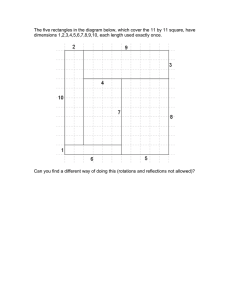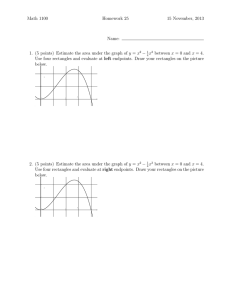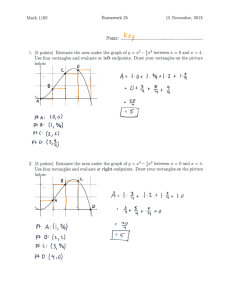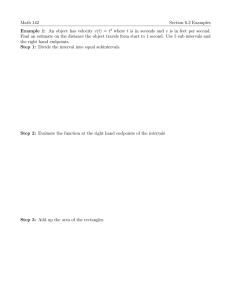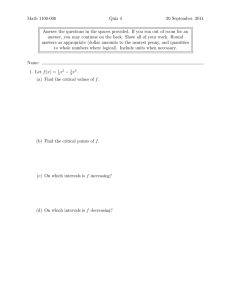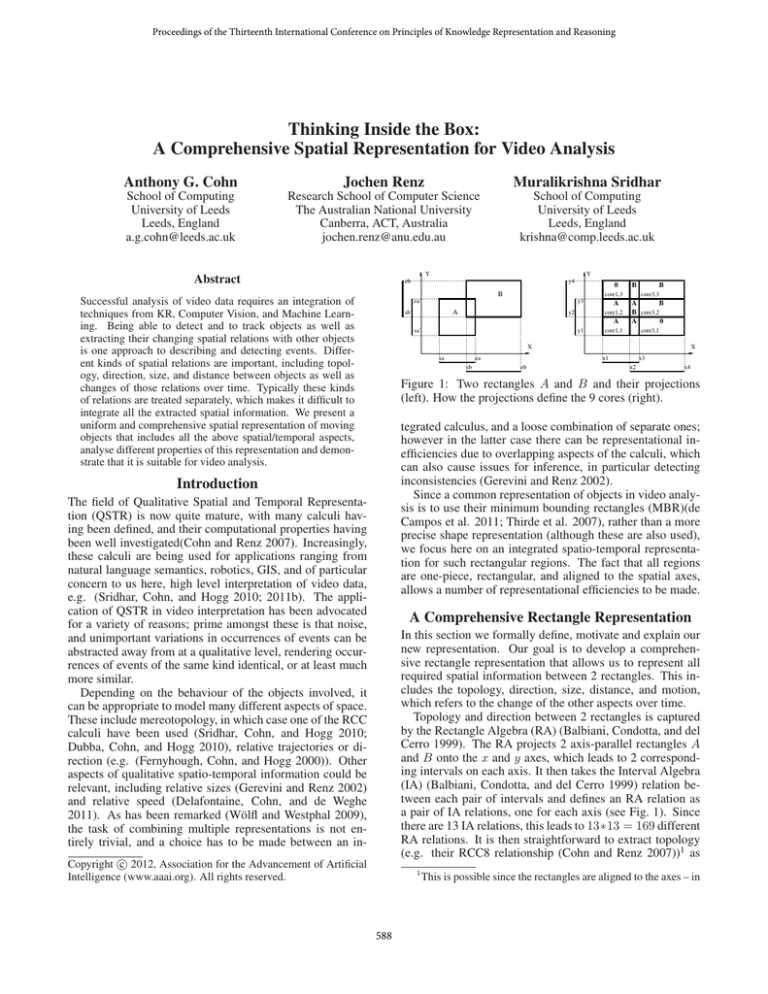
Proceedings of the Thirteenth International Conference on Principles of Knowledge Representation and Reasoning
Thinking Inside the Box:
A Comprehensive Spatial Representation for Video Analysis
Anthony G. Cohn
Jochen Renz
Muralikrishna Sridhar
School of Computing
University of Leeds
Leeds, England
a.g.cohn@leeds.ac.uk
Research School of Computer Science
The Australian National University
Canberra, ACT, Australia
jochen.renz@anu.edu.au
School of Computing
University of Leeds
Leeds, England
krishna@comp.leeds.ac.uk
Y
Abstract
Y
eb
y4
0
B
Successful analysis of video data requires an integration of
techniques from KR, Computer Vision, and Machine Learning. Being able to detect and to track objects as well as
extracting their changing spatial relations with other objects
is one approach to describing and detecting events. Different kinds of spatial relations are important, including topology, direction, size, and distance between objects as well as
changes of those relations over time. Typically these kinds
of relations are treated separately, which makes it difficult to
integrate all the extracted spatial information. We present a
uniform and comprehensive spatial representation of moving
objects that includes all the above spatial/temporal aspects,
analyse different properties of this representation and demonstrate that it is suitable for video analysis.
y3
A
sb’
B
core1,3
ea’
y2
A
core1,2
A
sa’
y1
B
core3,3
A
B
B core3,2
A
0
core1,1
core3,1
X
sa
ea
sb
X
x1
eb
x3
x2
x4
Figure 1: Two rectangles A and B and their projections
(left). How the projections define the 9 cores (right).
tegrated calculus, and a loose combination of separate ones;
however in the latter case there can be representational inefficiencies due to overlapping aspects of the calculi, which
can also cause issues for inference, in particular detecting
inconsistencies (Gerevini and Renz 2002).
Since a common representation of objects in video analysis is to use their minimum bounding rectangles (MBR)(de
Campos et al. 2011; Thirde et al. 2007), rather than a more
precise shape representation (although these are also used),
we focus here on an integrated spatio-temporal representation for such rectangular regions. The fact that all regions
are one-piece, rectangular, and aligned to the spatial axes,
allows a number of representational efficiencies to be made.
Introduction
The field of Qualitative Spatial and Temporal Representation (QSTR) is now quite mature, with many calculi having been defined, and their computational properties having
been well investigated(Cohn and Renz 2007). Increasingly,
these calculi are being used for applications ranging from
natural language semantics, robotics, GIS, and of particular
concern to us here, high level interpretation of video data,
e.g. (Sridhar, Cohn, and Hogg 2010; 2011b). The application of QSTR in video interpretation has been advocated
for a variety of reasons; prime amongst these is that noise,
and unimportant variations in occurrences of events can be
abstracted away from at a qualitative level, rendering occurrences of events of the same kind identical, or at least much
more similar.
Depending on the behaviour of the objects involved, it
can be appropriate to model many different aspects of space.
These include mereotopology, in which case one of the RCC
calculi have been used (Sridhar, Cohn, and Hogg 2010;
Dubba, Cohn, and Hogg 2010), relative trajectories or direction (e.g. (Fernyhough, Cohn, and Hogg 2000)). Other
aspects of qualitative spatio-temporal information could be
relevant, including relative sizes (Gerevini and Renz 2002)
and relative speed (Delafontaine, Cohn, and de Weghe
2011). As has been remarked (Wölfl and Westphal 2009),
the task of combining multiple representations is not entirely trivial, and a choice has to be made between an in-
A Comprehensive Rectangle Representation
In this section we formally define, motivate and explain our
new representation. Our goal is to develop a comprehensive rectangle representation that allows us to represent all
required spatial information between 2 rectangles. This includes the topology, direction, size, distance, and motion,
which refers to the change of the other aspects over time.
Topology and direction between 2 rectangles is captured
by the Rectangle Algebra (RA) (Balbiani, Condotta, and del
Cerro 1999). The RA projects 2 axis-parallel rectangles A
and B onto the x and y axes, which leads to 2 corresponding intervals on each axis. It then takes the Interval Algebra
(IA) (Balbiani, Condotta, and del Cerro 1999) relation between each pair of intervals and defines an RA relation as
a pair of IA relations, one for each axis (see Fig. 1). Since
there are 13 IA relations, this leads to 13∗13 = 169 different
RA relations. It is then straightforward to extract topology
(e.g. their RCC8 relationship (Cohn and Renz 2007))1 as
c 2012, Association for the Advancement of Artificial
Copyright Intelligence (www.aaai.org). All rights reserved.
1
588
This is possible since the rectangles are aligned to the axes – in
well as the external direction between A and B. To some
degree we can also obtain the internal direction between A
and B. Representation of motion is very limited in the RA
as it is only possible to represent changes of RA relations
over time, e.g. if (<, <) changes to (m, <) we know that
A moved closer to B on the x axis. That is we only represent qualitative changes in topology or direction, but cannot
represent intermediate changes such as “A is moving closer
to B” that do not lead to a change in topology or direction.
This requires additional size and distance information.
Consider again Fig. 1. The RA compares the interval relations between [sA , eA ] and [sB , eB ] and between [s0A , e0A ]
and [s0B , e0B ]. However, in order to represent relative movement of rectangles over time, we need to look at other intervals. E.g., assume that eA is before sB , then the relative change of the length of interval [eA , sB ] corresponds
to whether A moves closer to B or away from B in the xdirection. Similarly, if the 2 intervals [sA , eA ] and [sB , eB ]
overlap and if the interval [sB , eA ] becomes bigger, then
A and B overlap more. If [sB , eA ] becomes smaller, then
the area of B that is not overlapped by B becomes smaller.
These different intervals are also useful in the static case as it
allows us to express internal directions: e.g., that B is inside
A and that it is in the bottom left corner of A.
In this way each possible interval between the points sA ,
sB , eA , and eB on each axis carries information and allows
us to specify the relationship between 2 rectangles and how
it changes over time in a much more expressive way than
only considering RA relations.2 For 4 endpoints sA , sB ,
eA , and eB we get up to 6 different intervals between these
endpoints, on both axes up to 12.3 It will always be the
case that sA < eA and sB < eB , but depending on the
RA relation between A and B, it is possible that 2 of these
endpoints are identical and we get only 3 different intervals.
If 2 pairs are identical, we get only one interval on that axis.
on x or y, or the core widths and core heights, respectively.
It is clear that roi(A, B) consists of exactly 9 cores. Since
the underlying core intervals can have length 0, each core is
either a rectangle, a line segment, or a point. The cores form
a 3x3 grid that divide the roi into 9 zones. A core is either
part of A or not part of A and similarly for B. This leads
to 4 different states. We introduce a 5th state in order to
distinguish cores with a lower dimension.
Definition 2 (core state, region state). Given 2 rectangles
A, B ∈ U, their roi(A, B) and its 9 cores corei,j (A, B),
for 1 ≤ i, j ≤ 3, the state of a core, state(corei,j (A, B)), in
short statei,j (A, B), is defined as follows:
If corei,j (A, B) is a two dimensional region, then:
statei,j (A, B) = AB, iff corei,j (A, B) ⊆ A ∩ B
statei,j (A, B) = A, iff corei,j (A, B) ⊆ A − B
statei,j (A, B) = B, iff corei,j (A, B) ⊆ B − A
statei,j (A, B) = , iff corei,j (A, B) 6⊆ A ∧ corei,j (A, B) 6⊆B
If corei,j (A, B) is a line segment or a point, we
set its state to ∅. We write the state of roi(A, B) as
a 9-tuple state(A, B) = [state1,1 (A, B),state1,2 (A, B),
state1,3 (A, B),state2,1 (A, B),state2,2 (A, B),state2,3 (A, B),
state3,1 (A, B),state3,2 (A, B),state3,3 (A, B)]
Since A and B are rectangles, it is clear that not all states
are possible. In fact the set of all cores that are part of a single rectangle A, i.e., that have state A or AB, must always
form a rectangle too. Therefore, there are only 36 different possibilities of how A and B can be distributed over the
cores.
However, not all combinations of the 36x36 assignments
are possible states. E.g. if all 9 cores are part of A (and
thus have either state A or AB), then only the centre core
(core2,2 ) can have state AB, since in all other cases some
cores would have state ∅. We can show that only 169 different states are possible, corresponding exactly to the 169 RA
relations (see www.comp.leeds.ac.uk/qsr/cores for a depiction and their correspondence with the RA relations).
Theorem 1. Given 2 rectangles A, B and their roi(A, B),
there are 169 different states state(A, B); these have a 1to-1 correspondence to the 169 relations of the RA.
Independent of how the 2 rectangles move, the location
of each of the 9 cores with respect to its neighboring cores
always stays the same, they always touch each other at the
boundary. Since the cores can have zero width, it is possible
that non-neighboring cores touch each other as well. This
case is clearly determined by the state of the cores, and happens only if a core in the middle of a row or column (i.e.,
i = 2 or j = 2) has state ∅. Since location of cores and
corresponding RA relation between cores are determined by
state(A, B), which covers the topology and direction between rectangles, the main additional information we can
get is the size of cores as well as their width and height. It
is clear that all 3 cores in the same row have the same height
and that all 3 cores in the same column have the same width.
Therefore, the width and height of all cores only depends
on the length of the 6 corresponding core intervals [xi , xi+1 ]
and [yj , yj+1 ], respectively, for 1 ≤ i, j ≤ 3.
Topology and Direction We propose a representation that
captures all this information and allows a very detailed
and comprehensive representation of the spatial and spatiotemporal relationships between rectangles (see Fig. 1).
Definition 1 (region of interest, core). Given a 2D space
U with 2 reference axes x and y and 2 rectangles A, B ∈
U that are parallel to x and y. Projecting A and B to x
and y gives us 2 intervals [sA , eA ] and [sB , eB ] on x and
2 intervals [s0A , e0A ] and [s0B , e0B ] on y. For each axis, we
rename and order the 4 endpoints of the 2 intervals such that
x1 ≤ x2 ≤ x3 ≤ x4 and y1 ≤ y2 ≤ y3 ≤ y4 .
The region of interest for rectangles A, B (written
roi(A, B)) is the rectangle bounded by the intervals [x1 , x4 ]
and [y1 , y4 ]. The regions bounded by the intervals [xi , xi+1 ]
and [yj , yj+1 ] are the cores of roi(A, B), written as
corei,j (A, B), for 1 ≤ i, j ≤ 3. We call the intervals
[xi , xi+1 ] and [yj , yj+1 ] for 1 ≤ i, j ≤ 2 the core intervals
general, for non aligned rectangles and non-convex regions, it is not
possible to infer the RCC8 relationship from an RA relationship.
2
This holds even if we use what could be called RA-INDU, the
extension of RA that uses INDU (Pujari, Kumari, and Sattar 1999)
for representing relations between the underlying intervals.
3
These are called the implicit intervals of IA in (Renz 2012).
Size and Distance For the purpose of video analysis, the
589
exact values of the width, height, and area of cores is generally not important. Instead, we are mainly interested in
relative size measures. By comparing which core is larger
than which other core, we can infer information such as relative closeness of rectangles. E.g., A is contained in B and
is close to the bottom right corner of B. By comparing how
the size of a core at one time point compares to its size at
the next time point we can infer how objects move relative
to each other. Given 6 intervals, we have to keep track of
15 relative size comparisons (6 ∗ 5/2 = 15) between these
intervals. However, rectangles can consist of multiple cores
and in order to accurately compare their sizes, we may have
to compare the sizes of combinations of cores together. This
gives us 6 possible intervals on each axis, the 3 core intervals plus all possible unions of neighboring core intervals, a
total of 12 intervals. We call these 12 intervals the rectangle
intervals (RIs) [Xi , Xj ] and [Yi , Yj ] for any 1 ≤ i < j ≤ 4,
which give us 12 ∗ 11/2 = 66 different size comparisons.
A comparison of the relative size of the area of the 9 cores
requires keeping track of 9 ∗ 8/2 = 36 different relative size
relationships. A relative size comparison of all 36 possible
rectangles would lead to 36∗35/2 = 630 relationships, even
though many of them can be inferred from other relations.
Instead of keeping track of 66 different relative size comparisons between 2 rectangles A and B, we choose a more
compact representation of the relative size of their cores. We
take the 12 RIs and determine their total order with respect
to their length. Some of these intervals might have the same
length and for some, the order is predetermined due to one
being contained in the other. We then assign each of the 12
RIs its rank in the total order, with rank 1 being assigned
to the smallest interval. Intervals of same size will get the
same rank. If m intervals have the same rank k, then the
next largest interval will get rank k + m. The highest rank
is less than 12 if the largest interval has the same length as
another interval. It is clear that we can obtain each of the 66
different relative size relations between the 12 RIs by comparing their rank: if they have equal rank, they have equal
size, the one with lower rank is smaller.
Changes over Time When comparing changes over different time points, we can compare same with same, or we can
compare everything with everything. In this paper we restrict ourselves to the same with same case and we compare
each core with itself at different time points to see how the
cores change. If we compare the relative height and width
of cores, we need 6 comparisons altogether, for the area we
need 9 comparisons, one for each core. We can also compare
changes over time between sets of cores forming rectangles,
in which case we have to compare 12 different intervals over
different time points. For comparing changes over time for
all possible rectangles formed by cores, we need 36 comparisons. The changes are recorded using a change function.
Definition 3 (change function, changes). Given a set V of
k variables v1 , . . . , vk over a domain D and an order relation R on D. Vt is the assignment of values from D to
each variable of V at time point t. We define a change
function ch(V) : V 7→ {<, =, >} where ch(vt ) = ‘=’ if
vt − vt−1 = 0, ch(vt ) = ‘<’ if vt−1 − vt < 0, and ch(vt ) =
‘>’ if vt − vt−1 < 0. The changes from Vt−1 to Vt for
each of the k variables of V, written as ch(V), is the k-tuple
[ch(v1 ), . . . , ch(vk )].
Integrating all the concepts we defined so far gives us a
compact representation of the relevant qualitative information about 2 rectangles.
Definition 4 (rank, ranking). Given a set V of k variables
v1 , . . . , vk over a domain D and an order relation R on D.
For each assignment of values to variables in V, we can sort
V with respect to R. rank(v) : V 7→ {1, . . . , k} is the rank
of v ∈ V wit respect to R, where same value implies same
rank. The ranking of V, written as ranking(V), is the ktuple [rank(v1 ), . . . , rank(vk )].
Definition 5 (CORE-9, CORE-9+ , CORE-9++ ). Given 2
rectangles A, B ∈ U, their roi(A, B), the set C(A,B) of 9
+
cores corei,j (A, B), for 1 ≤ i, j ≤ 3, the set C(A,B)
that
consists of all 36 unions of cores that form rectangles, the
set of 6 core intervals CI (A,B) , and the set of 12 rectangle
intervals CI +
(A,B) . In order to refer to a specific element
in CI (A,B) we use as superscript the interval/core we are
[x1 ,x2 ]
[2,3]
referring to, e.g. CI (A,B)
, or C(A,B) .
CORE-9(A, B, t) is a qualitative representation of rectangles A and B at time t with the following components:
state(A, B), the state of the 9 different cores;
ranking(C(A,B) ), the ranking of the core areas;
ranking(CI (A,B) ), the ranking of the core intervals;
ch(C(A,B) ), the changes of C(A,B) compared to time t − 1;
ch(CI (A,B) ), the changes of CI (A,B) compared to time t−1
CORE-9+ uses the 12 RIs CI +
(A,B) instead of CI (A,B) . In
+
++
addition, CORE-9
also uses C(A,B)
instead of C(A,B)
A CORE-9 relation is any valid assignment of
state(A, B),
ranking(CI (A,B) ),
ranking(C(A,B) ),
change(C(A,B) ), and change(CI (A,B) ).
Building an Integrated Representation In order to obtain
qualitative information from video, we have to detect and
track the relevant objects and their MBRs. For every pair
of MBRs A, B and in every frame, we then record the 4 x
and the 4 y coordinates of the 4 lines bounding A and B
in both directions. These coordinates define the 9 cores as
described above. We then determine the status of each core
with respect to A and B. This is all the information we need
to extract. All qualitative relations can be inferred from this
information: the RA relations between A and B which give
us topology and direction are derived from state(A, B), all
relative size information between the cores can be derived
from the x and y coordinates of the bounding lines.
Note that ch(CI (A,B) ) and ch(C(A,B) ) are not com[x2 ,x3 ]
pletely independent. E.g. if ch(CI (A,B)
) =‘<’ and
[y ,x ]
[2,1]
1 2
ch(CI (A,B)
) =‘<’, then ch(C(A,B) ) must be ‘<’ too.
Expressiveness of CORE-9
CORE-9 integrates a number of different aspects of space.
We have already shown that it covers the RA relations, that
is topology and direction between rectangles; indeed, one
590
of the 9 cores and analyse which changes to the 2 represented rectangles can cause these changes. There are only
two kinds of small continuous changes that have this effect:
(1) if the two rectangles share a common edge segment at
one time point and the change affects the common edge,
or (2) if the two rectangles share a common edge segment
which they previously did not share. Since the change is
continuous, this means that one of the core intervals changes
from non-zero length to zero length, or from zero length to
non-zero length. It is clear that for cores corresponding to
these core intervals the status changes between ∅ and either
A, B, or AB. We can show in a simple case analysis that all
other cores keep their previous states.
Apart from these changes to the state of cores, continuous
changes to the rectangles also lead to continuous changes
in the sizes of core and RIs. It is clear that these changes
lead to smooth and local changes of the sizes relations of
the intervals. However, CORE-9 does not represent these
relations directly, but only the rank of intervals with respect
to their relative size. By analysing how the rank of intervals
can change and how this depends on continuous change, we
can show that intervals that are not involved in a change do
not change their rank, and that intervals that are involved
change rank at most to the next higher or lower rank.
Continuous changes of the represented rectangles are also
recorded in the ch(...) entries of CORE-9. Clearly these entries only change locally, and they change as smoothly as
the rectangles change. As a consequence of our analysis, we
obtain the following theorem.
can straightforwardly define RCC-8 relations from CORE-9
and the relations of a qualitative direction calculus such as
the Cardinal Direction Calculus (CDC) (Ligozat 1998). It
is fairly straightforward to show that it also covers relative
size and relative distance and, what is more, that it integrates
these 4 aspects. With this integration, it is possible to further
refine the different aspects. E.g., we can refine the topological overlap relation by direction, i.e., from which direction
one rectangle overlaps the other. We can further refine them
by relative size, e.g. how much of a rectangle overlaps the
other one, and by relative distance. Relative distance in combination with the other types of relations is very powerful. It
allows us, for example, to specify if a rectangle overlaps another one closer to the left or right, the top or bottom. Other
relative distance measures can further refine the overlap relationship. We can make similar refinements for the other
topological relations. In addition, CORE-9 allows us to represent changes of these relations over time. Because of the
relative distance relations, we can also express that rectangles approach each other or move away from each other,
overlap more or overlap less, and in which directions, in
effect defining a form of the QTC calculus ((Delafontaine,
Cohn, and de Weghe 2011) for rectangles, which could be
used, e.g. to model action sequences such as overtaking cars
in a qualitative natural way.
CORE-9 encodes much more than just RCC, CDC and
QTC. It is clear that relative size information is also explicitly encoded, via the ranking function of Definition 5. This
allows us, for example, to represent that A is in the bottom
left of B, or that A overlaps B in the x direction more than
in the y direction. CORE-9 can also encode much more directional information than is possible in CDC: it can encode
internal directions, e.g. to represent that A is in the NE of
B. Also for the case of QTC, it can handle cases where A
and B are not disjoint, so that it is possible to represent, e.g.,
that A is part of B, and that it is moving west. CORE-9 can
also represent that a region is growing or contracting.
There are some things that CORE-9 cannot represent.
Relative speed is one such aspect (the third component of
most QTC family calculi) – it would require comparisons
between arbitrary RIs at different times, not just the same
ones (as is the case in the present ranking function). This
would be a straightforward extension.
Theorem 2. CORE-9 is a smooth and local representation,
that is, continuous changes to the represented rectangles
lead to a smooth and local change in the representation.
An HMM Framework For Smoothed Relations
In this section we briefly report on 2 experiments comparing
the efficacy of the proposed uniform representation against
the combination of separate representations on actual video
data. First we show that an approach that models topology
and direction jointly performs better in obtaining smoothed
relations, and secondly that this jointly obtained representation is better at event detection.
We can exploit a Hidden Markov Model (HMM) to obtain
smoothed relations from noisy video data, extending the approach of (Sridhar, Cohn, and Hogg 2011a), which showed
that jitter of RCC8 relations could be thus reduced. The temporal model used the CN graph (CNG) of RCC8: each state
of the HMM is labelled with an RCC8 relation. The transition probabilities are defined using the CNG of RCC8 in
such a way that transitions to the same state have a relatively higher probability compared to the transition between
states allowable in the CNG and transitions between states
not possible according to the CNG have a zero transition
probability. A novel distance measure between regions provided the observations for the HMM. The probability distribution between the states and the observations was modelled
by an observation model for each state. It is possible to extend this formalism and design a HMM for CORE-9. Our
current implementation does not extend to the full CORE-9
representation yet, but focuses on comparing single Multi-
Smoothness of CORE-9
A very important property that any useful qualitative representation should have is smoothness, i.e., if there are small
changes to what is being represented, there should only be
small changes in the representation. Ideally, only parts of
the representation should change, that correspond to parts
that are changing, i.e., changes should be local. Having
smooth and local changes is particularly important for representing moving objects in video, where there are often small
changes between every frame. It allows us to define a metric of similarity between different core representations that
captures the degree of change – if only local changes exist,
then two representations will be broadly similar.
In the following, we sketch how small continuous changes
affect our representation. We begin with changes to the state
591
Acknowledgements The first and third authors acknowledge financial support of the DARPA Mind’s Eye program
(project VIGIL, W911NF-10-C-0083). The second author
is supported by an ARC Future Fellowship (FT0991917).
Observation HMM (MOHMM) whose input is defined in
terms of a vector intervals on the x and y axes against the
relations produced by a pair of non-integrated HMMs for
each of the topological and directional aspects separately (a
Parallel HMM architecture – PaHMM(Chen et al. 2009)),
so that at any time it is possible to infer a pair of topological
and directional respectively. Manually annotated spatial relationships are used both for training the parameters of the
HMMs and for evaluating them. The evaluation dataset consists of 36 videos each of 150200 frames and containing one
or more of 6 verbs: approach, bounce, catch, jump, kick and
lift (a subset of the videos and verbs at www.visint.org). The
evaluation of the HMMs involved determining the extent to
which the episodes output by the system temporally align
with those of the ground truth. Accuracy was measured in
terms of the mean and variance of the percentage of temporal overlap, between the outcome of each of the HMMs and
the ground truth in a 10-fold cross validation: the MOHMM
had an accuracy of 72.5%, while the PaHMM with the separate representations only had 62%.
In a second experiment, the relationships between pairs
of object tracks obtained by each of the HMMs were rerepresented in terms of a 3 layered graph structure called
interaction graphs(Sridhar, Cohn, and Hogg 2010; 2011b),
between which a similarity measure can be defined and used
to perform learning tasks such as event detection. We used
the event detection framework of the latter paper to learn 2
sets of event models arising from the interaction graphs obtained using PaHMM and the MOHMM respectively. An
event was regarded as being detected if the detected interval
overlapped the ground-truth interval by more than 50%. On
a leave-one out cross validation the event models arising out
of the PaHMM outputs yielded a mean F1 score of 38.6%,
while the MoHMM yielded 44.5%. Thus in both experiments the integrated representation outperformed the representations computed separately, giving supporting evidence
for the benefits of the integrated CORE-9 representation. A
full set of experiments for CORE-9 remains to be conducted.
References
Balbiani, P.; Condotta, J.-F.; and del Cerro, L. F. 1999. A
new tractable subclass of the rectangle algebra. In Proceedings of IJCAI’99, 442–447.
Chen, C.; Liang, J.; Zhao, H.; Hu, H.; and Tian, J. 2009.
Factorial HMM and parallel HMM for gait recognition.
IEEE Transactions on Systems, Man, and Cybernetics, Part
C 39(1):114–123.
Cohn, A. G., and Renz, J. 2007. Qualitative spatial reasoning. In van Harmelen, F.; Lifschitz, V.; and Porter, B., eds.,
Handbook of Knowledge Representation. Elsevier.
de Campos, T.; Barnard, M.; Mikolajczyk, K.; Kittler, J.;
Yan, F.; Christmas, W. J.; and Windridge, D. 2011. An
evaluation of bags-of-words and spatio-temporal shapes for
action recognition. In WACV.
Delafontaine, M.; Cohn, A. G.; and de Weghe, N. V. 2011.
Implementing a qualitative calculus to analyse moving point
objects. Expert Syst. Appl. 38(5):5187–5196.
Dubba, K. S. R.; Cohn, A. G.; and Hogg, D. C. 2010. Event
model learning from complex videos using ILP. In Proc.
ECAI, 93–98.
Fernyhough, J.; Cohn, A.; and Hogg, D. 2000. Constructing qualitative event models automatically from video input.
Image and Vision Computing 18:81–103.
Gerevini, A., and Renz, J. 2002. Combining topological and
size information for spatial reasoning. Artif. Intell. 137(12):1–42.
Ligozat, G. 1998. Reasoning about cardinal directions. J.
Vis. Lang. Comput. 9(1):23–44.
Pujari, A. K.; Kumari, G. V.; and Sattar, A. 1999. Indu: An
interval and duration network. In Proc. of Australian Joint
Conference on AI, 291–303.
Renz, J. 2012. Implicit constraints for qualitative spatial and
temporal reasoning. In Proc. KR.
Sridhar, M.; Cohn, A. G.; and Hogg, D. C. 2010. Unsupervised learning of event classes from video. In Proc. AAAI,
1631–1638. AAAI Press.
Sridhar, M.; Cohn, A. G.; and Hogg, D. C. 2011a. From
video to RCC8: Exploiting a distance based semantics to
stabilise the interpretation of mereotopological relations. In
COSIT, volume 6899 of LNCS, 110–125. Springer.
Sridhar, M.; Cohn, A. G.; and Hogg, D. C. 2011b. Benchmarking qualitative spatial calculi for video activity analysis. In Proc. IJCAI Workshop Benchmarks and Applications
of Spatial Reasoning, 15–20.
Thirde, D.; Borg, M.; Aguilera, J.; Wildenauer, H.; Ferryman, J. M.; and Kampel, M. 2007. Robust real-time tracking
for visual surveillance. EURASIP J. Adv. Sig. Proc. 2007.
Wölfl, S., and Westphal, M. 2009. On combinations of
binary qualitative constraint calculi. In Boutilier, C., ed.,
IJCAI, 967–973.
Final Comments
Video analysis presents a challenge to the field of KR. It requires us not only to detect and track objects in video, but to
infer what the objects are doing. QSTR provides an effective representation for this task as the exact location and extent of the objects we track is typically much less important
than their qualitative relationships. Many different QSTRs
have been proposed. The hypothesis we have started to explore in this paper is that an integrated representation may
prove to be more effective, as well as being arguably more
elegant. Our representation is suited for representing rectangles, which is appropriate when objects are represented by
their MBR. Our representation is very compact and can be
easily and smoothly extracted from video. This integrated
approach appears to give better performance on event detection as demonstrated in a sample dataset.
A variety of future work is possible; some of this has already been alluded to above. A more thorough experimental
evaluation is also required. A further avenue is to extend the
HMM smoothing to all aspects of the CORE-9 representation, specifically, the relative size information.
592

